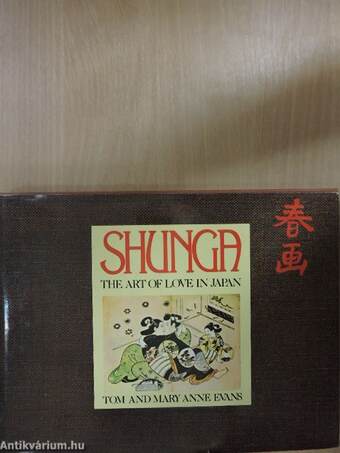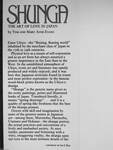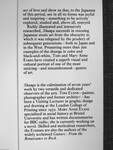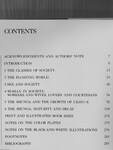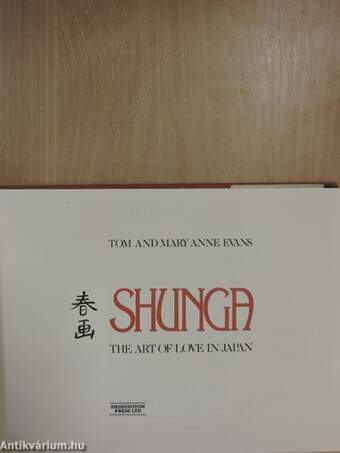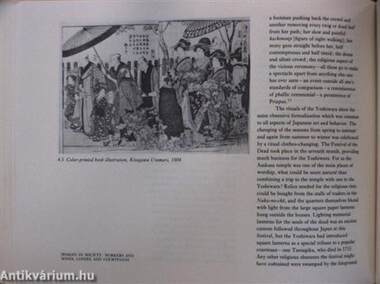1.067.017
kiadvánnyal nyújtjuk Magyarország legnagyobb antikvár könyv-kínálatát

VISSZA
A TETEJÉRE
JAVASLATOKÉszre-
vételek
Shunga
The Art of Love in Japan
| Kiadó: | Paddington Press Ltd. |
|---|---|
| Kiadás helye: | New York |
| Kiadás éve: | |
| Kötés típusa: | Ragasztott kemény kötés |
| Oldalszám: | 284 oldal |
| Sorozatcím: | |
| Kötetszám: | |
| Nyelv: | Angol |
| Méret: | 22 cm x 29 cm |
| ISBN: | 0-8467-0066-2 |
| Megjegyzés: | Számos fekete-fehér és néhány színes reprodukcióval. További grafikusok a kötetben. |
naponta értesítjük a beérkező friss
kiadványokról
naponta értesítjük a beérkező friss
kiadványokról
Fülszöveg
SHÜMGB
THE ART OF LOVE IN JAPAN by Tom and Mary Anne Evans
Enter Ukiyo—the "fleeting, floating world" inhabited by the merchant class of Japan in the i7th to 19A centuries.
Physical love as a means of self-expression and as an art form has always assumed a greater importance in the East than in the West. In the uninhibited atmosphere of Ukiyo, erotic art and literature was openly produced and widely enjoyed; and it was here that Japanese eroticism found its truest and most perfect expression: in the famous wood-block prints known as the Ukiyo-e shunga.
"Shunga" is the generic name given to the erotic paintings, prints and illustrated books of Japan. Translated literally, it means "spring drawings" . . . and it is a quality of spring-like freshness that the best of the shunga possess.
Drawn with skill and imagination by somé of the greatest names in Japanese art—among them, Moronobu, Harunobu, Utamaro and Hokusai—the shunga portray the sexual practices and conventions of a... Tovább
Fülszöveg
SHÜMGB
THE ART OF LOVE IN JAPAN by Tom and Mary Anne Evans
Enter Ukiyo—the "fleeting, floating world" inhabited by the merchant class of Japan in the i7th to 19A centuries.
Physical love as a means of self-expression and as an art form has always assumed a greater importance in the East than in the West. In the uninhibited atmosphere of Ukiyo, erotic art and literature was openly produced and widely enjoyed; and it was here that Japanese eroticism found its truest and most perfect expression: in the famous wood-block prints known as the Ukiyo-e shunga.
"Shunga" is the generic name given to the erotic paintings, prints and illustrated books of Japan. Translated literally, it means "spring drawings" . . . and it is a quality of spring-like freshness that the best of the shunga possess.
Drawn with skill and imagination by somé of the greatest names in Japanese art—among them, Moronobu, Harunobu, Utamaro and Hokusai—the shunga portray the sexual practices and conventions of a lively and unabashed society. At once tender, passionate and brimming with a witty, swaggering vitality, the shunga open our eyes to the most intimate details of the
continued on back flap
act of love and show us that, to the Japanese of this period, sex in all its forms was joyful and inspiring—something to be actively explored, studied and, above all, enjoyed.
Richly illustrated and intensively researched, Shunga sueceeds in rescuing Japanese erotic art from the obscurity to which it was relegated by the prudery of subsequent generations—both in Japan and in the West. Presenting more than 200 examples of the shunga in color and black-and-white, Tom and Mary Anne Evans have created a superb visual and cultural portrait of one of the most enticing—and misunderstood—genres of art.
Shunga is the culmination of seven years' work by two versatile and dedicated observers of the arts. Tom Evans—painter, photographer and former architeci—has been a Visiting Lecturer in graphic design and drawing at the London College of Printing since 1972. Mary Anne Evans specialized in social history at Bristol University and has written documentaries for BBC radio; she is currently working on a növel. Skilled and meticulous researchers, the Evanses are alsó the authors of the widely acclaimed Guitars: From the Renaissance to Rock. Vissza
Témakörök
- Idegennyelv > Idegennyelvű könyvek > Angol > Művészetek > Festészet
- Idegennyelv > Idegennyelvű könyvek > Angol > Művészetek > Művészettörténet, általános
- Idegennyelv > Idegennyelvű könyvek > Angol > Művelődéstörténet
- Művelődéstörténet > Kultúra > Története
- Idegennyelv > Idegennyelvű könyvek > Angol > Szex, szerelem
- Művészetek > Művészettörténet általános > Társadalom és művészet > Egyéb
- Művészetek > Művészettörténet általános > Kontinensek művészete > Ázsia > Keleti
- Művészetek > Művészettörténet általános > Idegen nyelv > Angol
- Művészetek > Festészet > Rajz, grafika > Technikák > Fametszet
- Művészetek > Festészet > Rajz, grafika > Története > Külföldi > Egyéb
- Művészetek > Festészet > Rajz, grafika > Illusztrációk
- Művészetek > Festészet > Idegen nyelv > Angol
- Művészetek > Festészet > Tanulmányok, összefoglalók > Külföldi
- Szex, szerelem > Szex, szerelem a művészetekben > Festészet, grafika
- Szex, szerelem > Kultúrtörténet > Keleti kultúrkör
- Szex, szerelem > Idegennyelvű
- Erotika > Erotikus művészet > Festészet, grafika > Erotikus, akt
- Erotika > Kultúrtörténet > Keleti kultúrkör
- Idegennyelv > Idegennyelvű könyvek > Angol
Megvásárolható példányok
Nincs megvásárolható példány
A könyv összes megrendelhető példánya elfogyott. Ha kívánja, előjegyezheti a könyvet, és amint a könyv egy újabb példánya elérhető lesz, értesítjük.



